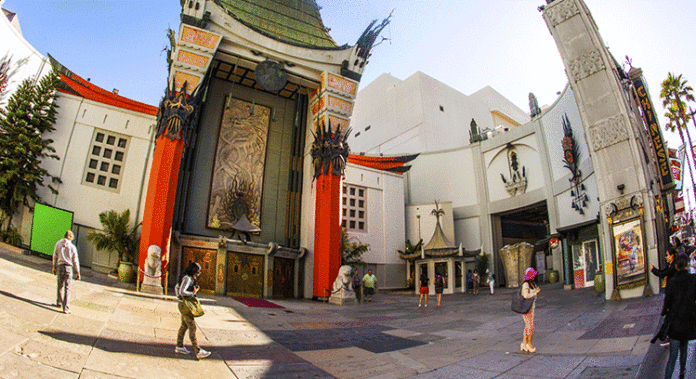
ONE OF THE most famous landmarks in the world and one that pays homage to the world of entertainment celebrates its 90th birthday on Thursday.
First opening its doors on May 18th 1927, the Grauman’s Chinese Theatre, known under naming rights as TCL Chinese Theatre, is a movie palace on the historic Hollywood Walk of Fame at 6925 Hollywood Boulevard in California.
Originally known as Grauman’s Chinese Theatre, it was renamed Mann’s Chinese Theatre in 1973, which lasted until 2001, before reverting to its original name.
The original Chinese Theatre was commissioned following the success of the nearby Grauman’s Egyptian Theatre, which opened in 1922. Built by a partnership headed by Sid Grauman over 18 months starting in January 1926, the theatre opened with the premiere of Cecil B. DeMille’s film The King of Kings. It has since been home to many premieres, including the 1977 launch of George Lucas’ Star Wars, and has hosted three Academy Awards ceremonies.
Among the theatre’s most distinctive features are the concrete blocks set in the forecourt, which bear the signatures, footprints, and handprints of popular motion picture personalities from the 1920s to the present day.
In 2013 the Chinese Theatre partnered with IMAX Corporation to convert the house into a custom designed IMAX theatre. The newly renovated theatre seats 932 people and features one of the largest movie screens in North America.
During construction of the theatre, Grauman hired Jean Klossner to build a hard concrete forecourt of the theatre which became the home for the famous prints. But what was the origin of them?
The theatre’s official account in its books and souvenir programs credit Norma Talmadge as having inspired the tradition when she accidentally stepped into the wet concrete. However, in a short interview during the September 13, 1937, Lux Radio Theatre broadcast of a radio adaptation of A Star Is Born, Grauman related another version of how he got the idea to put hand and foot prints in the concrete. He said it was “…pure accident. I walked right into it. While we were building the theatre, I accidentally happened to step in some soft concrete. And there it was. So, I went to Mary Pickford immediately. Mary put her foot into it.”
Still another account by the construction foreman, Jean Klossner, recounts that Klossner autographed his work next to the right-hand poster kiosk and that he and Grauman developed the idea then and there. His autograph and handprint, dated 1927, remain today. The theatre’s third founding partner, Douglas Fairbanks, was the second celebrity, after Talmadge, to be immortalized in the concrete.
One of the highlights of the Chinese Theatre has always been its grandeur and décor. In 1952, John Tartaglia, the artist of nearby Saint Sophia Cathedral, became the head interior decorator of the Chinese Theatre as well as the theatre chain then owned by Fox West Coast Theatres.
The Chinese Theatre was declared a historic and cultural landmark in 1968, and has since undergone various restoration projects in the years since then.
The exterior of the theatre is meant to resemble a giant, red Chinese pagoda. The design features a huge Chinese dragon across the façade, with two authentic Ming Dynasty guardian lions (“heavenly dogs”) guarding the main entrance and the silhouettes of tiny dragons along the sides of the copper roof. To the dismay of many historic architecture fans, the free-standing ticket booth, installed in the 1930s, and the left and right neon marquees have been removed—but their absence restores the theatre to its original appearance. The auditorium has been completely restored, along with much of the exterior; however, the wear and tear on the physical structure over the years has caused some of the external décor to be removed, rather than repaired.
Many Hollywood films have had their premieres at the Chinese Theatre throughout its history. Today, premieres are attended by celebrities and a large number of fans, just as they have been since 1927.
There are nearly 200 Hollywood celebrity handprints, footprints, and autographs in the concrete of the theatre’s forecourt.
Variations of this honoured tradition are imprints of the eyeglasses of Harold Lloyd, the cigar of Groucho Marx, the wands used by Harry Potter stars Daniel Radcliffe, Emma Watson, and Rupert Grint, the facial profile of John Barrymore (reflecting his nickname “The Great Profile”), and the legs of Betty Grable. Western stars William S. Hart and Roy Rogers left imprints of their guns. Herbie, a Volkswagen Beetle, left the imprints of his tires. The hoofprints of “Tony”, the horse of Tom Mix, “Champion”, the horse of Gene Autry, and “Trigger”, the horse of Rogers, were left in the concrete beside the prints of the stars who rode them in the movies.
Since 2011, there has been a surge of concrete ceremonies, many of which have been paid for by movie studios for publicity reasons. One of the theatre’s current owners, Donald Kushner, acknowledged this and referred to them as mock ceremonies.
This influx has been a matter of concern for film buffs and historians, as well as misleading for fans. However, despite the increase of cement blocks, the ones placed within the forecourt are still chosen by a special committee who selects celebrities based on their contributions to Hollywood cinema.








